Waste Durian Husk Fibers as Natural Sound Absorber: Performance and Acoustic Characterization
Abstract
:1. Introduction
2. Methodology
2.1. About Durian
2.2. Preparation of Test Samples
2.3. Measurement Setup
3. Measured Results and Analysis
3.1. Absorption Performance with Thickness
3.2. Absorption Performance with Density
4. Determination of Acoustical Properties
- Porosity,
- Tortuosity,
- Flow resistivity,
- Viscous characteristic length,
- Thermal characteristic length,
4.1. Propagation Model
4.2. Optimization Function
4.3. Computational Results
5. Conclusions
Author Contributions
Funding
Institutional Review Board Statement
Informed Consent Statement
Data Availability Statement
Conflicts of Interest
References
- Asdrubali, F.; D’Alessandro, F.; Schiavoni, S. A review of unconventional sustainable building insulation materials. Sustain. Mater. Technol. 2015, 4, 1–17. [Google Scholar] [CrossRef]
- Or, K.H.; Putra, A.; Selamat, M.Z. Oil palm empty fruit bunch fibres as sustainable acoustic absorber. Appl. Acoust. 2017, 119, 9–16. [Google Scholar] [CrossRef]
- Lim, Z.; Putra, A.; Nor, M.; Yaakob, M. Sound absorption performance of natural kenaf fibres. Appl. Acoust. 2018, 130, 107–114. [Google Scholar] [CrossRef]
- Putra, A.; Or, K.H.; Selamat, M.Z.; Nor, M.J.M.; Hassan, M.H.; Prasetiyo, I. Sound absorption of extracted pineapple-leaf fibres. Appl. Acoust. 2018, 136, 9–15. [Google Scholar] [CrossRef]
- Santoni, A.; Bonfiglio, P.; Fausti, P.; Marescotti, C.; Mazzanti, V.; Mollica, F.; Pompoli, F. Improving the sound absorption performance of sustainable thermal insulation materials: Natural hemp fibres. Appl. Acoust. 2019, 150, 279–289. [Google Scholar] [CrossRef]
- Borrell, J.G.; Sanchis, E.J.; Alcaraz, J.S.; Belda, I.M. Sustainable sound absorbers from fruit stones waste. Appl. Acoust. 2020, 161, 107174. [Google Scholar] [CrossRef]
- Cherradi, Y.; Rosca, I.C.; Cerbu, C.; Kebir, H.; Guendouz, A.; Benyoucef, M. Acoustic properties for composite materials based on alfa and wood fibers. Appl. Acoust. 2021, 174, 107759. [Google Scholar] [CrossRef]
- Boubel, A.; Garoum, M.; Bousshine, S.; Bybi, A. Investigation of loose wood chips and sawdust as alternative sustainable sound absorber materials. Appl. Acoust. 2021, 172, 107639. [Google Scholar] [CrossRef]
- Sasikumar, K.; Saravanan, N.; Sambathkumar, M.; Guekndran, R. Acoustic characterization of farm residues for sound absorption applications. Mater. Today Proc. 2020, 33, 2917–2922. [Google Scholar] [CrossRef]
- Yun, B.Y.; Cho, H.M.; Kim, Y.U.; Lee, S.C.; Berardi, U.; Kim, S. Circular reutilization of coffee waste for sound absorbing panels: A perspective on material recycling. Environ. Res. 2020, 184, 109281. [Google Scholar] [CrossRef] [PubMed]
- Singh, S.; Mohanty, A. HVAC noise control using natural materials to improve vehicle interior sound quality. Appl. Acoust. 2018, 140, 100–109. [Google Scholar] [CrossRef]
- Abdi, D.D.; Monazzam, M.; Taban, E.; Putra, A.; Golbabaei, F.; Khadem, M. Sound absorption performance of natural fiber composite from chrome shave and coffee silver skin. Appl. Acoust. 2021, 182, 108264. [Google Scholar] [CrossRef]
- Wikipedia. Durian. 2021. Available online: https://en.wikipedia.org/w/index.php?title=Durian&oldid=1007963645 (accessed on 20 February 2021).
- Lazim, Z.M.; Hadibarata, T.; Puteh, M.H.; Yusop, Z.; Wirasnita, R.; Nor, N.M. Utilization of durian peel as potential adsorbent for bisphenol a removal in aquoeus solution. J. Teknol. 2015, 74, 109–115. [Google Scholar]
- Haryati, S.; Putri, R.W. Torrefaction of Durian peel and bagasse for bio-briquette as an alternative solid fuel. In Proceedings of the 3rd International Conference on Chemical Engineering Sciences and Applications 2017 (3rd ICChESA 2017), Banda Aceh, Indonesia, 20–21 September 2017; Volume 334, p. 012008. [Google Scholar]
- Charoenvai, S. New insulating material: Binderless particleboard from durian peel. In Advances in Civil Engineering and Building Materials; Taylor & Francis Group: London, UK, 2013; pp. 119–123. [Google Scholar]
- Charoenvai, S. Durian peels fiber and recycled HDPE composites obtained by extrusion. Energy Procedia 2014, 56, 539–546. [Google Scholar] [CrossRef] [Green Version]
- Sembiring, T.; Sebayang, K.; Sinuhaji, P. Characterization of Biocomposite Materials based on the Durian Fiber (Durio Zibethinus Murr) Reinforced using Polyester Resin. J. Phys. Conf. Ser. 2018, 1116, 032031. [Google Scholar] [CrossRef]
- Jiménez, N.; Romero-García, V.; Groby, J.P. Perfect absorption of sound by rigidly-backed high-porous materials. Acta Acust. United Acust. 2018, 104, 396–409. [Google Scholar] [CrossRef]
- Fahy, F.; Thompson, D. Fundamentals of Sound and Vibration; CRC Press: Boca Raton, FL, USA, 2016. [Google Scholar]
- Mareze, P.H. Análise Da Influência Da Microgeometria Na Absorção Sonora De Materiais Porosos De Estrutura Rígida (in portuguese). Ph.D. Thesis, Universidade Federal de Santa Catarina, Florianópolis, Brazil, 2013. [Google Scholar]
- Allard, J.; Atalla, N. Propagation of Sound in Porous Media: Modelling Sound Absorbing Materials, 2nd ed.; John Wiley & Sons: Hoboken, NJ, USA, 2009. [Google Scholar]
- Zwikker, C.; Kosten, C.W. Sound Absorbing Materials; Elsevier: Amsterdam, The Netherlands, 1949. [Google Scholar]
- Johnson, D.L.; Koplik, J.; Dashen, R. Theory of dynamic permeability and tortuosity in fluid-saturated porous media. J. Fluid Mech. 1987, 176, 379–402. [Google Scholar] [CrossRef]
- Allard, J.F.; Champoux, Y. New empirical equations for sound propagation in rigid frame fibrous materials. J. Acoust. Soc. Am. 1992, 91, 3346–3353. [Google Scholar] [CrossRef]
- Putra, A.; Oliveira, T.; Souli, M.; Kassim, D.H. Characterizing and modeling of acoustical performance of natural sound absorber. In Multiphysics Simulations in Automotive and Aerospace Applications; Elsevier: Amsterdam, The Netherlands, 2021; pp. 49–64. [Google Scholar]
- Pereira, M.; Carbajo San Martín, J.; Godinho, L.; Amado-Mendes, P.; Mateus, D.; Ramis-Soriano, J. Acoustic behavior of porous concrete. Characterization by experimental and inversion methods. Mater. Constr. 2019, 69. [Google Scholar] [CrossRef]
- Horoshenkov, K.V.; Swift, M. The acoustic properties of granular materials with pore size distribution close to log-normal. J. Acoust. Soc. Am. 2001, 110, 2371–2378. [Google Scholar] [CrossRef] [PubMed]
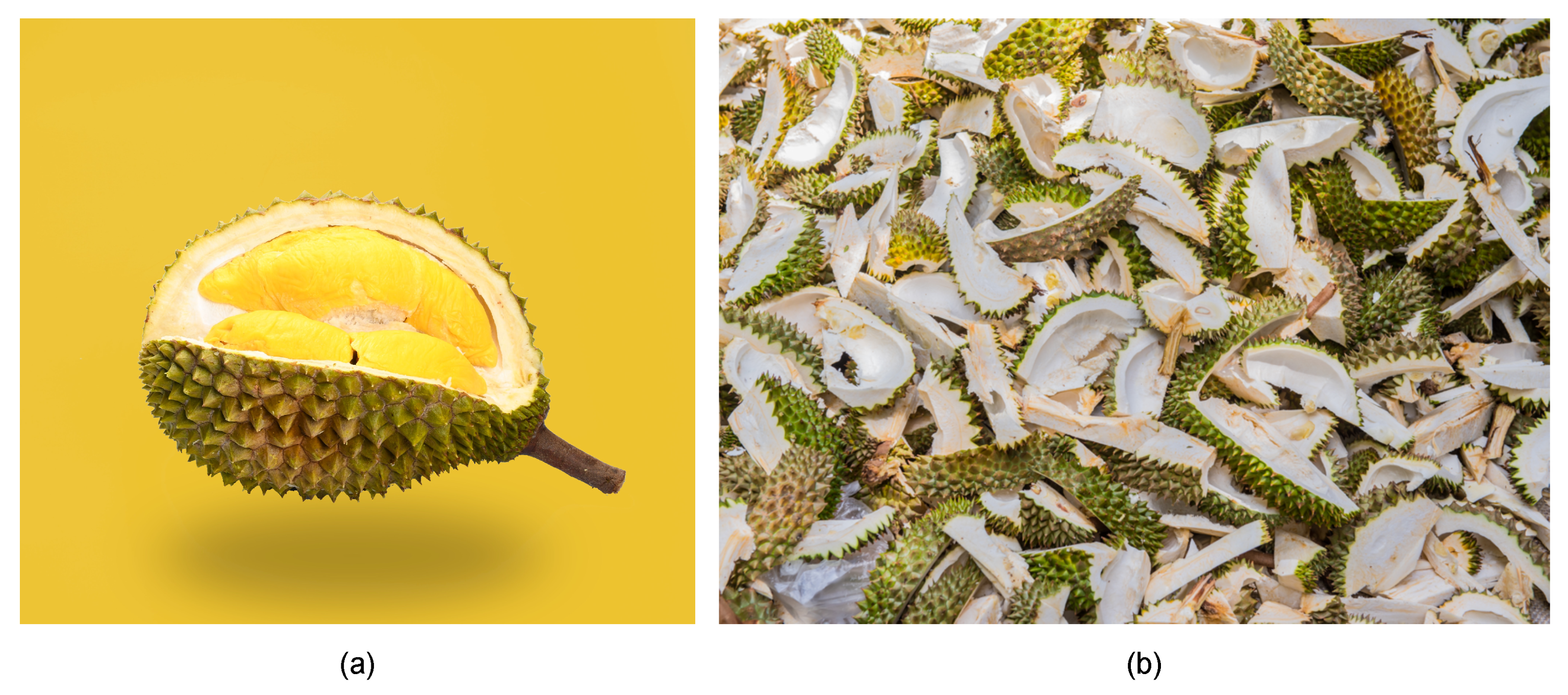
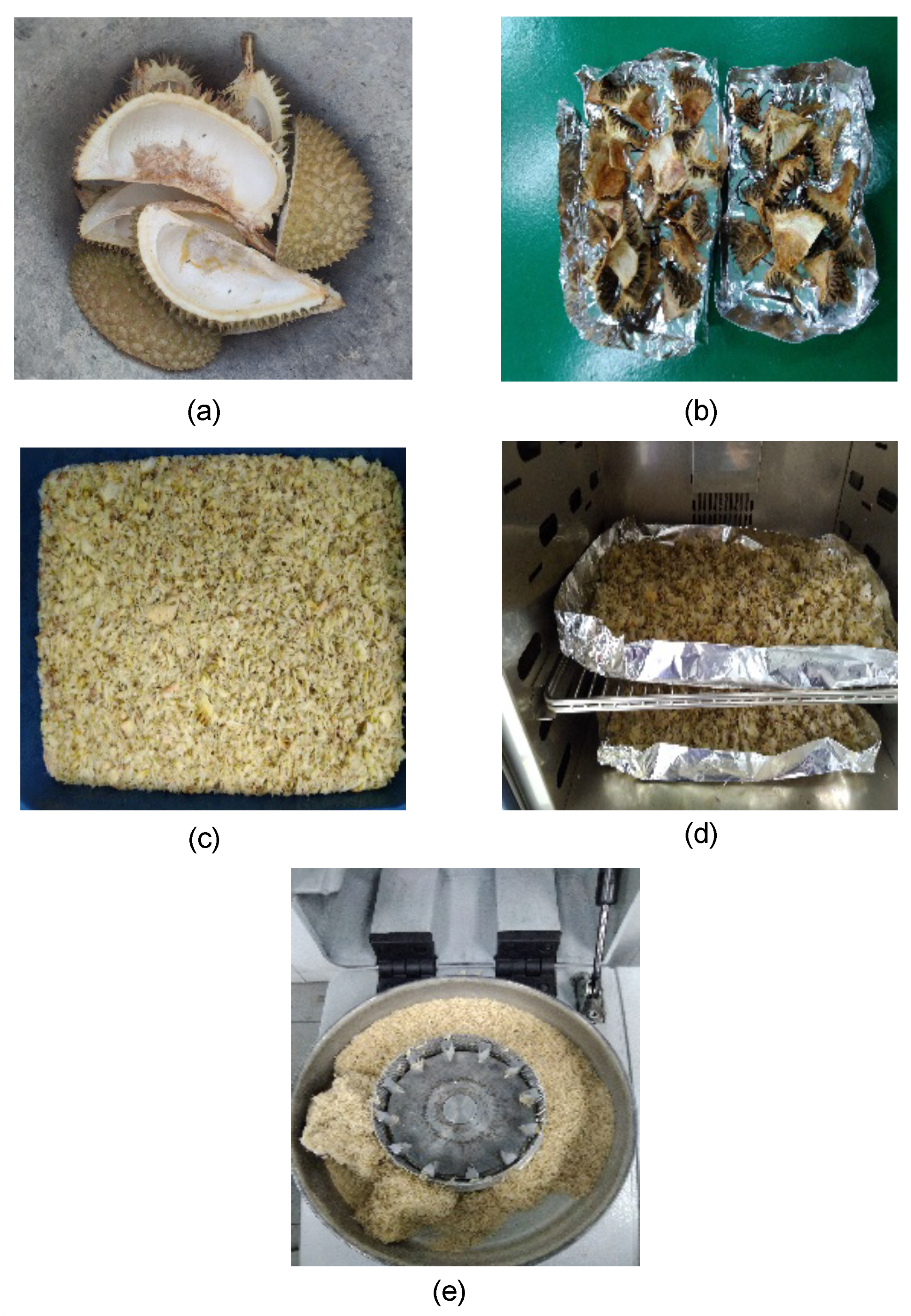
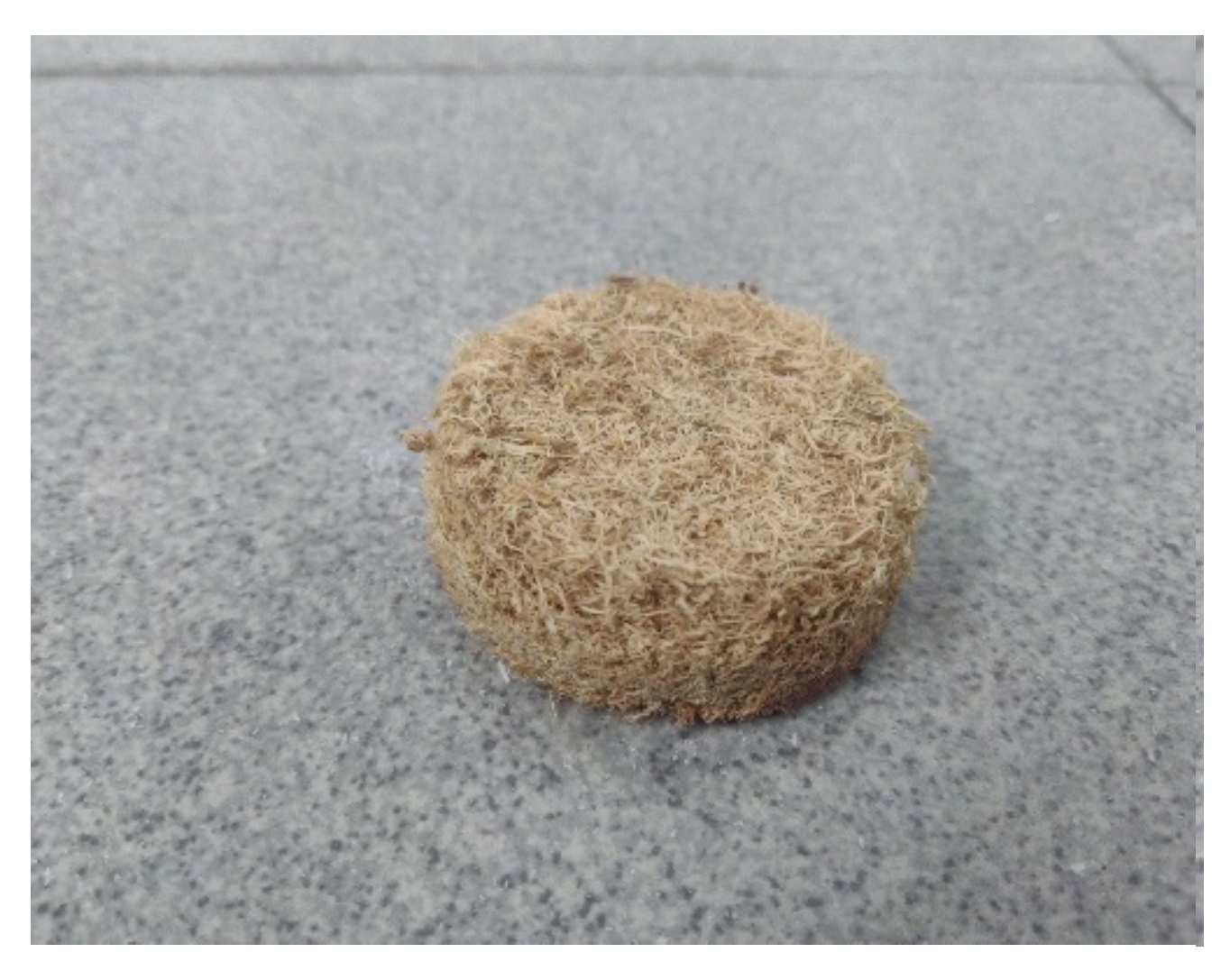
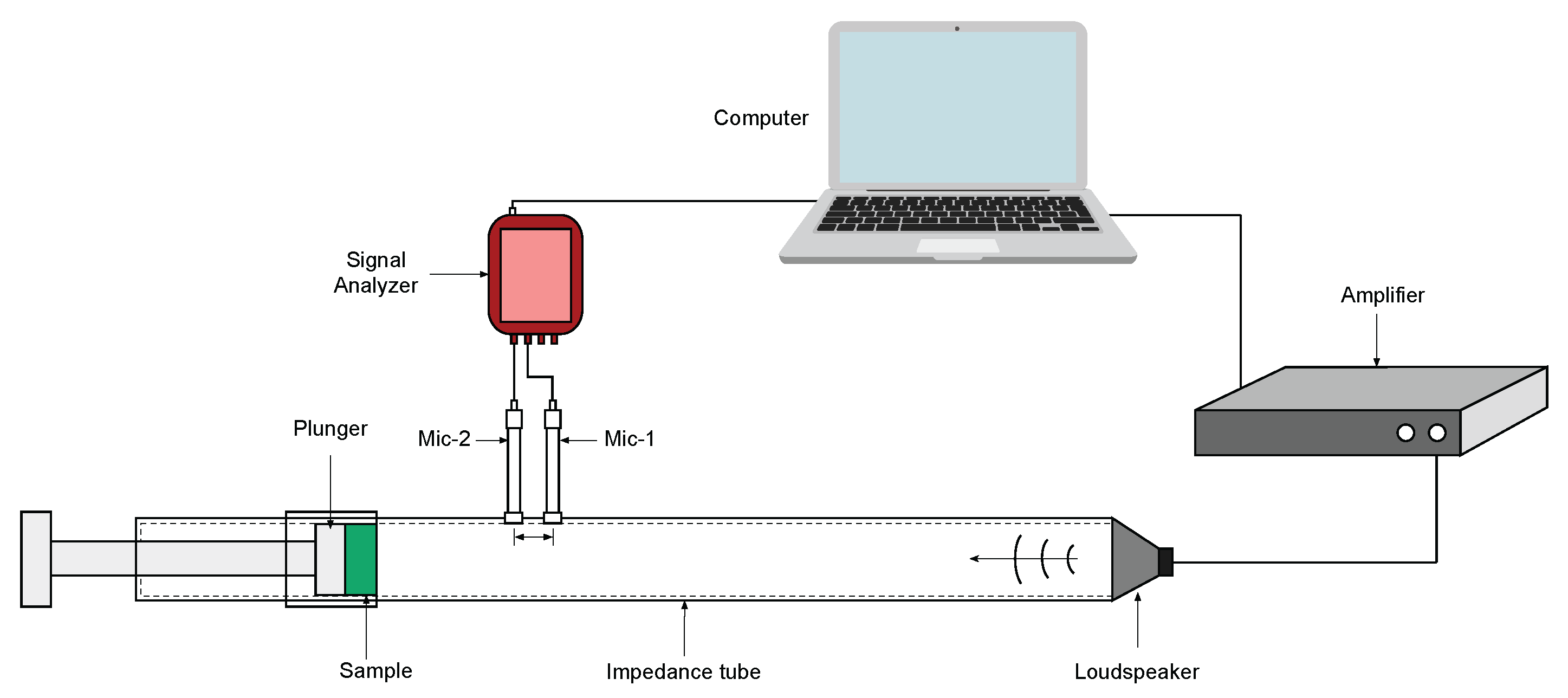
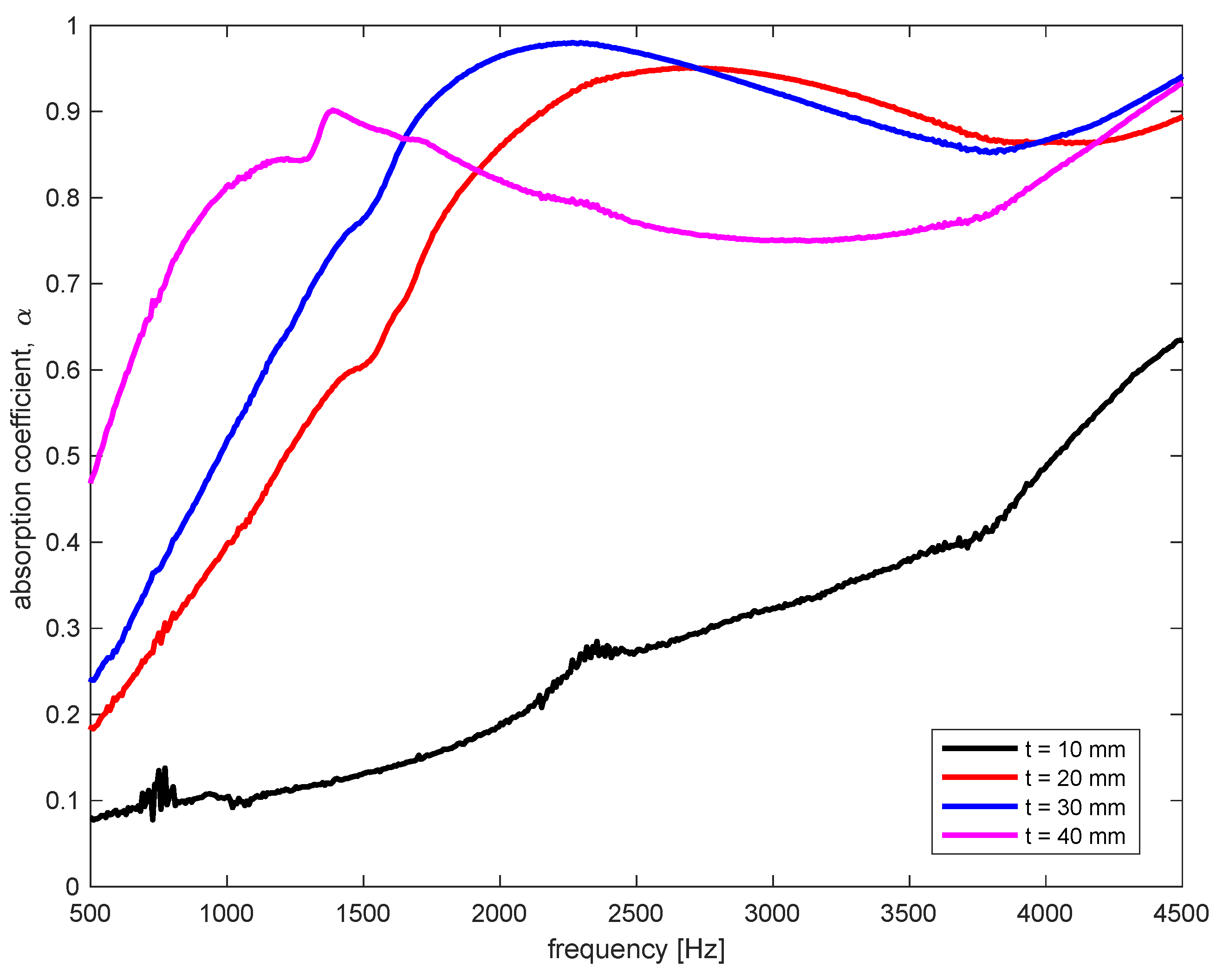

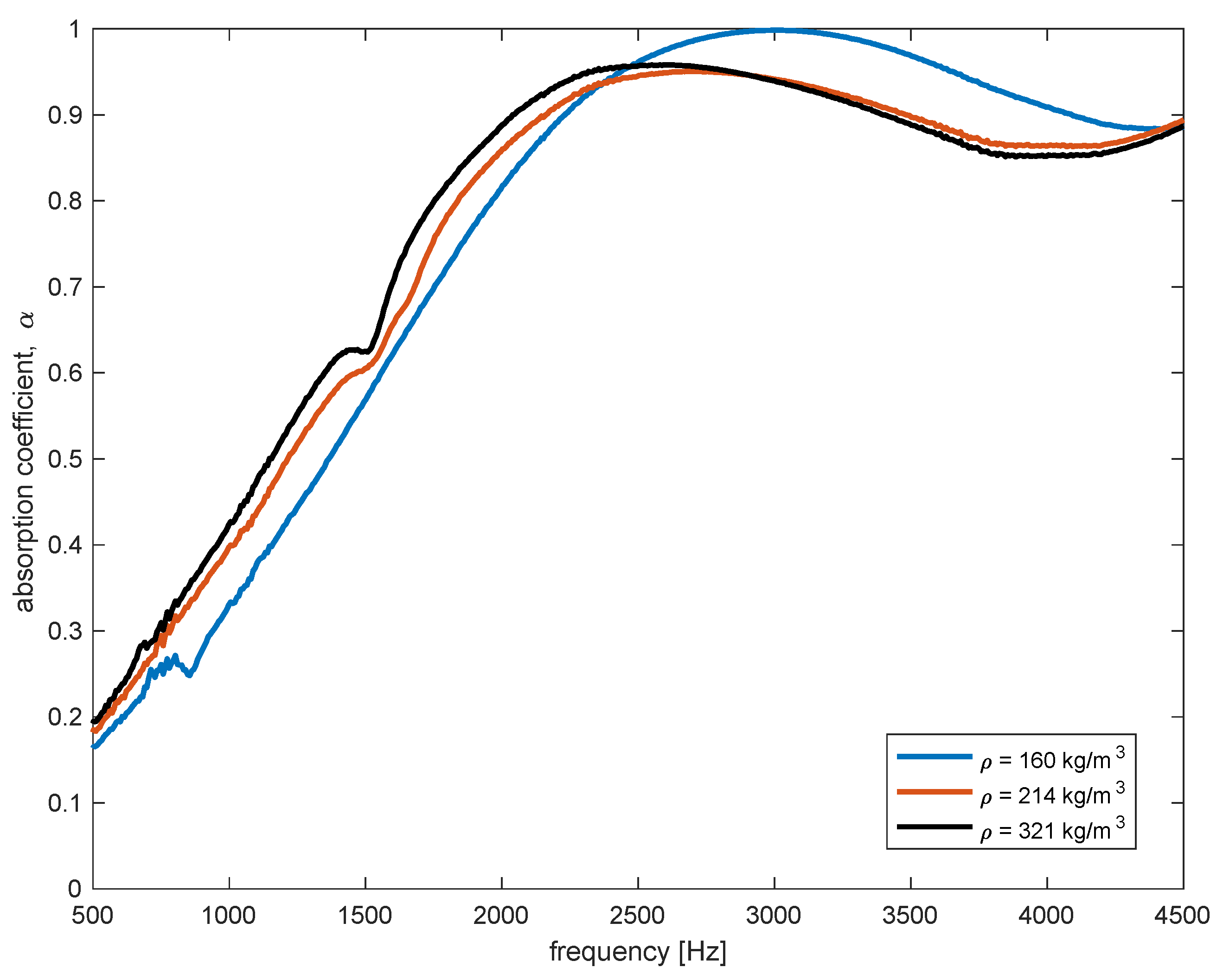

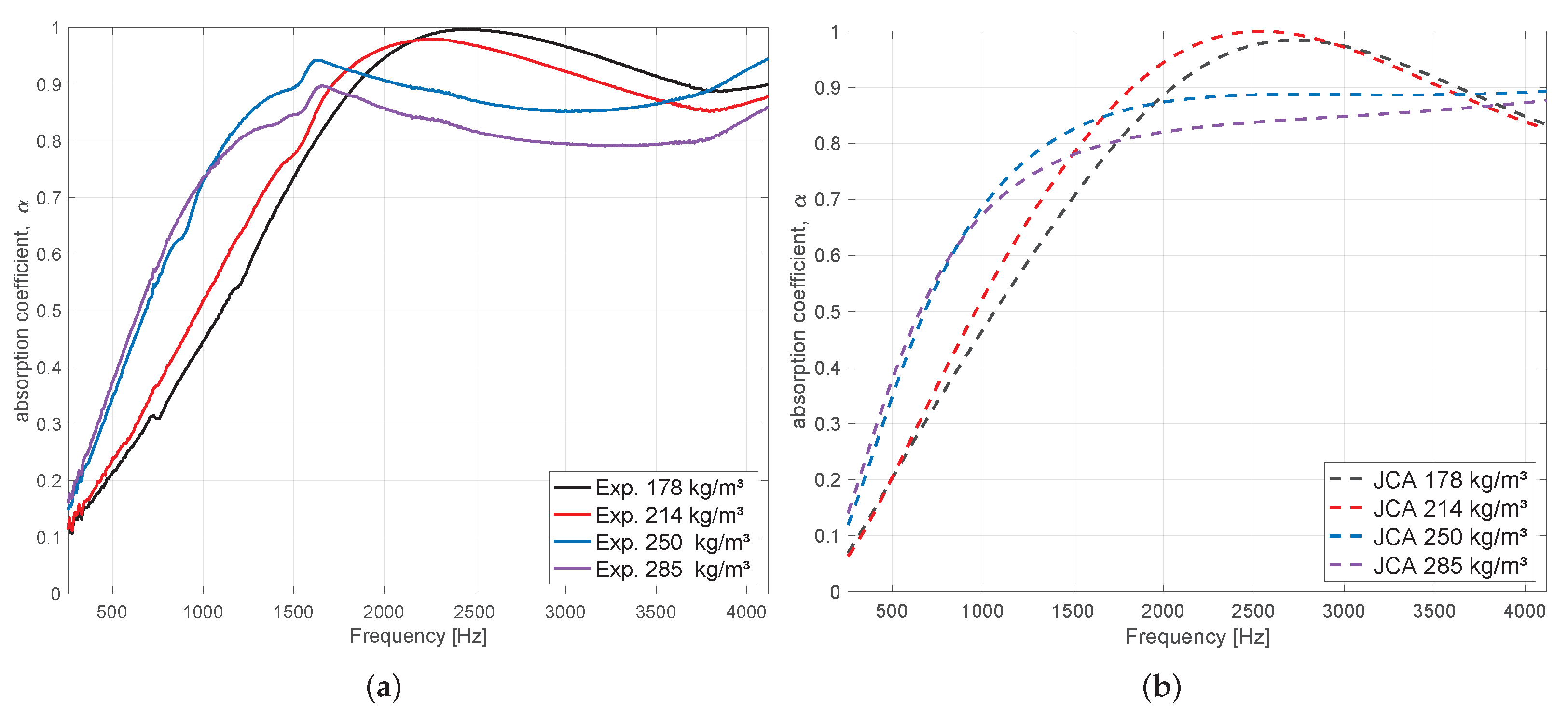
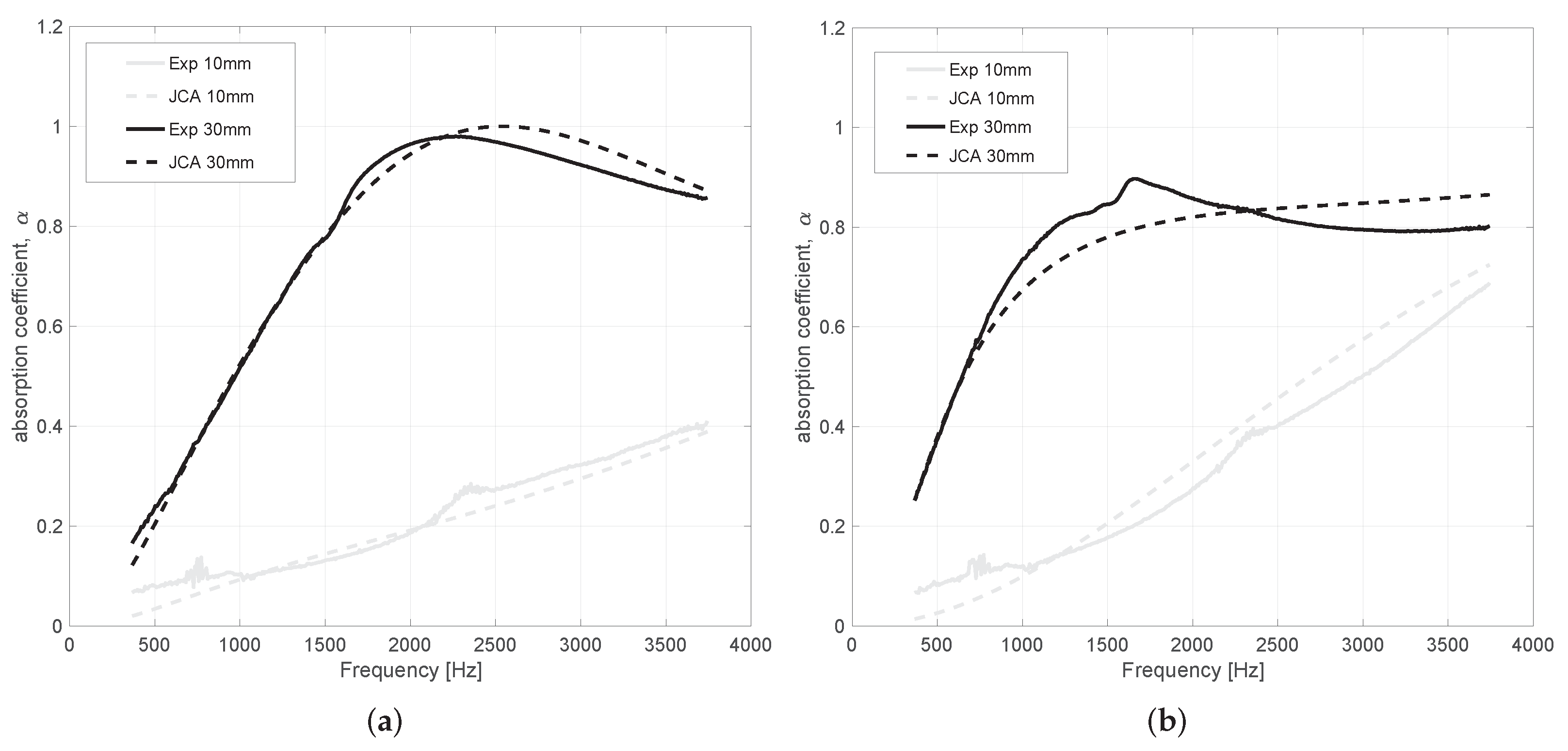
| Mass of Fibers, m (g) | Thickness, t (mm) | Bulk Density, (kg/m3) |
|---|---|---|
| 2 | 10 | 214 |
| 3 | 20 | 160 |
| 4 | 20 | 214 |
| 6 | 20 | 321 |
| 5 | 30 | 178 |
| 6 | 30 | 214 |
| 7 | 30 | 250 |
| 8 | 30 | 285 |
| 8 | 40 | 214 |
| Density [kg/m3] | [kN/m4] | [-] | [-] | [μm] | [μm] |
|---|---|---|---|---|---|
| 178 | 17.1 | 0.73 | 1.03 | 118 | 176 |
| 214 | 23.1 | 0.68 | 1.06 | 94 | 142 |
| 250 | 56.9 | 0.77 | 1.05 | 53 | 54 |
| 285 | 70.1 | 0.76 | 1.06 | 48 | 50 |
| Density (kg/m3) | 10 mm | 30 mm |
|---|---|---|
| 214 | 2.36% | 2.32% |
| 285 | 4.77% | 4.62% |
Publisher’s Note: MDPI stays neutral with regard to jurisdictional claims in published maps and institutional affiliations. |
© 2022 by the authors. Licensee MDPI, Basel, Switzerland. This article is an open access article distributed under the terms and conditions of the Creative Commons Attribution (CC BY) license (https://creativecommons.org/licenses/by/4.0/).
Share and Cite
Putra, A.; Othman, M.N.; Oliveira, T.; Souli, M.; Kassim, D.H.; Irianto; Herawan, S. Waste Durian Husk Fibers as Natural Sound Absorber: Performance and Acoustic Characterization. Buildings 2022, 12, 1112. https://doi.org/10.3390/buildings12081112
Putra A, Othman MN, Oliveira T, Souli M, Kassim DH, Irianto, Herawan S. Waste Durian Husk Fibers as Natural Sound Absorber: Performance and Acoustic Characterization. Buildings. 2022; 12(8):1112. https://doi.org/10.3390/buildings12081112
Chicago/Turabian StylePutra, Azma, Muhammad Nur Othman, Thaynan Oliveira, M’hamed Souli, Dg Hafizah Kassim, Irianto, and Safarudin Herawan. 2022. "Waste Durian Husk Fibers as Natural Sound Absorber: Performance and Acoustic Characterization" Buildings 12, no. 8: 1112. https://doi.org/10.3390/buildings12081112
APA StylePutra, A., Othman, M. N., Oliveira, T., Souli, M., Kassim, D. H., Irianto, & Herawan, S. (2022). Waste Durian Husk Fibers as Natural Sound Absorber: Performance and Acoustic Characterization. Buildings, 12(8), 1112. https://doi.org/10.3390/buildings12081112







